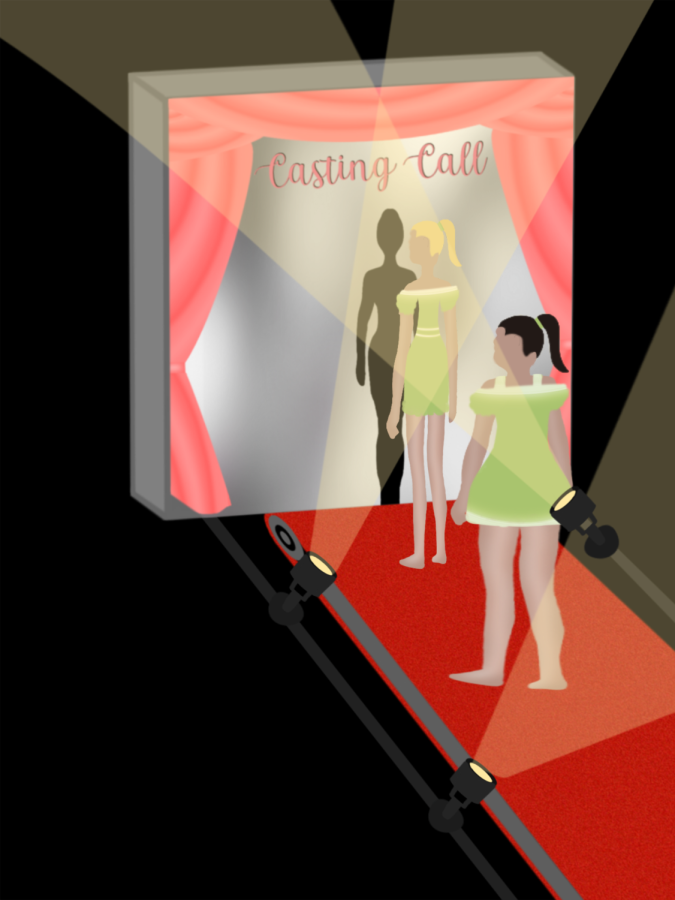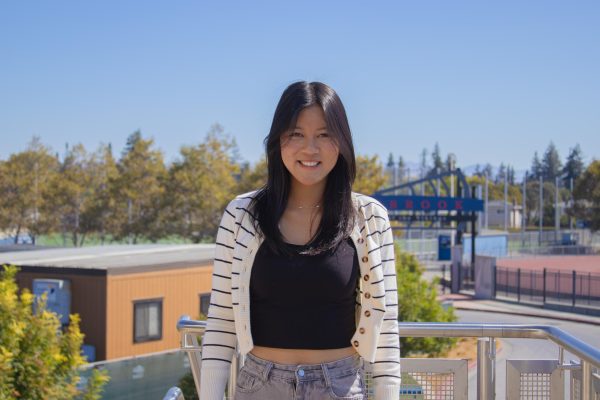Picture-perfect models on poisoned runways
Graphic illustration by Ashley Huang
The modeling industry’s favoritism towards a certain body type is depicted through a wall with a silhouette of the ideal body type that models must get through in order to be casted.
March 10, 2023
A light shines on the runway and the audience grows silent, holding their breaths in anticipation of the impending show. Out walks a striking model with chiseled cheekbones, long legs and a skinny waist. As more stream onto the runway, each girl seems to be a duplicate of the previous, with the same thin figure. Despite the modeling industry’s proclamations to become more inclusive and recruit plus-size models, many companies fall short of taking real action. Many brands in the high fashion industry publicize their performative attempts to be progressive, yet lack genuine progress. Their adherence to unrealistic beauty standards creates insecurities, promoting unhealthy diets and eating disorders in younger audiences.
“Mainstream representation of tall thin body types promotes an unhealthy standard to the audience and can cause them to develop insecurities about their own bodies, especially within the younger audience,” senior Russell Lin said.
By primarily showcasing skinny models on the runway or in ads, the modeling industry has glorified an ideal body where one must have a slim waist, hourglass figure and long legs to be considered beautiful. This can also be seen in the commercial industry where clothing companies such as Victoria’s Secret and Brandy Melville cater to similar standards. Victoria’s Secret has a past of exclusively representing women with one body type — skinny and tall. In 2019, the company hired their first plus-sized model, who claimed to be a body positivity activist, yet had a history of making fatphobic comments on social media. After the model’s comments were revealed, it became clear that her employment was only an act to temporarily appease public outcry and avoid long term scrutiny.
Similar to Victoria’s Secret, Brandy Melville promotes the saying, one size fits all, yet carries clothes solely catered to slimmer body types. Consequently, consumers have become fixated on their idea of the perfect body and tend to resort to unhealthy methods to attain such a physique. Many engage in unhealthy dieting, excessive exercise or other harmful weight-controlling behaviors, often leading to eating disorders. This also creates a culture of fatphobia, in which plus-size people are shamed for their appearance.
“A lot of brands and designers create clothing to fit the beauty standards of an hourglass figure, which the majority of their audience does not have,” junior Crystal Lee said. “A lot of brands have very limited ranges that are not reflective of different body types, and this leaves many customers to feel unincluded.”
While many people are pushing back against these unrealistic body standards, there are still those who argue having plus-size models in ads or on the runway normalizes an unhealthy lifestyle. Commenters on the Brandy Melville Instagram account argued that those pointing out the lack of inclusivity were simply blaming a clothing brand for their personal insecurities about their weight and should either go to the gym or work on their self-confidence. However, these arguments are flawed for several reasons. They assume that all plus-size models are indulging in unhealthy behaviors when, in actuality, many are healthy and active. Additionally, there are many other factors that are often out of one’s control, such as genetics or other preexisting conditions, that dictate how fast some people gain weight and therefore it is unfair to reduce it to a matter of laziness or lack of willpower. Promoting plus-size models doesn’t advertise an unhealthy lifestyle, but rather aids in body diversity and inclusivity.
“It really helps the audience feel more included and beautiful when they see someone in high fashion or ads that look like them, whether that be a similar size or body structure,” senior Janice Chong said.
The industry’s unrealistic beauty standards create significant problems for models as well. Models are expected to maintain a certain weight and body structure in order to be successful. To achieve that desired body, many diet consistently or use laxatives and other drugstore staples such as conjugated linoleic acid, to prevent natural hunger. There have been reports of models dying due to anorexia and the unhealthy diets they put themselves on to lose weight. The modeling industry also often uses photo editing software to make or dilute curves on models and edit out natural blemishes or stretch marks that are considered unappealing, resulting in more unrealistic definitions of beauty.
“The industry creates a false image of what models should look like, and this makes people believe that this kind of body is their dream body,” sophomore Gabrielle Kasper said. “People go to extremes and do many harmful things to their body to try to attain an unrealistic body image.”
Although there are still many brands that are still unaccepting of diverse body types, others such as Adidas, Old Navy and American Eagle have proved to be more inclusive, hiring plus-size models to promote their larger size range. Similarly, modeling agencies like Alaeria and We Speak Model Management have begun to showcase plus-size models.
Despite the narrative perpetuated by the model industry, everybody is different, and as such, achieving a specific build can be simply unattainable. By recruiting plus-size models, companies have begun challenging narrow beauty standards and encouraging a more inclusive society, which they should continue to do in a more widespread manner.




























































